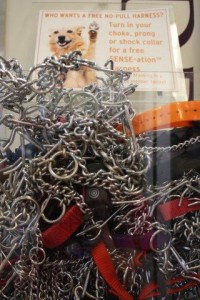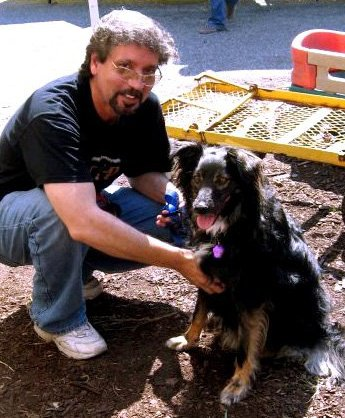Over 400 choke, prong, and shock collars have piled up as almost as many people have taken up the Human Society of Boulder Valley’s (HSBV) No-Choke Challenge. “Turn in your choke, prong, or shock collar for a free SENSE-ation or Weiss Walkie harness!”
As Lisa Pedersen, CEO of HSBV, aptly said:
At the end of the day, the cornerstone of our mission is healthy relationships between pets and people. So as we provide people solutions and resources (the harnesses), we attempt to do two things: resolve the behavior issue (pulling on leash) AND positively impact the relationship between the person and their pet. This is why we love the no-pull harness over other tools – it achieves both goals.
Seems likes a feel-good story. Right? Not so fast.
A couple of weeks ago the local newspaper decided to stir the kibble cup by publishing an article saying that the HSBV’s No-Choke Challenge is upsetting others in the community who use shock, choke and prong collars to rehabilitate and train dogs. Apparently some felt personally affronted.
The usual controversies flew frisbee fast in the comments section of the newspaper. If you are so inclined you can read them here.
One of the arguments often used in favor of using aversive methods is that some dogs, sometimes referred to as “red-zone dogs,” just need a stronger hand. Usually this means using punishment (shocking, choking) for undesired behavior along with a little negative reinforcement. For example, if the trainer is shocking or “stimulating” the dog, the trainer stops the electric current when the dog performs the desired behavior, sitting down, for example. In this way the dog is reinforced for sitting by the discomfort or pain of the shock being removed.
Often this position is framed as “do or die”: The only way to save the dog’s life by transforming him from aggressive to a good candidate for adoption is by using aversive methods. Some dogs need really tough training.
Frankly, I don’t buy it. I don’t believe there is a special class of difficult dogs (you’re about to meet a very difficult dog in a moment) who only can be rehabilitated and trained with aversives.
I thought it would be more interesting to share a real-life example of a very difficult, agressive dog who has been rehabilitated and trained using positive methods rather than launch into a theoretical argument to back up my point of view. You’ve heard it all before.
Since I don’t have personal experience with such a dog, I sought out someone who does. Leah Roberts of Dog Willing suggested I contact John Visconti and ask him about his dog, Pepper.
Meet John and Pepper. The first of six installments of his and Pepper’s story follows. But, before I turn my blog over to John, allow me to introduce him. John is a dog trainer and owner of Long Island Dog and Puppy Training. He has extensive shelter experience and writes for several publications including a regular column called “Of Dogs and Men” for The APDT Chronicle of the Dog.
Thank you John for writing this amazing story for Boulder Dog. I’m honored to publish it. And, Leah! Thank you for suggesting I contact John.
Part 1. JOHN MEETS PEPPER
She was abandoned by her original owners approximately 15 miles from her home. After living an undetermined amount of time on the street as a stray, she was seized by the police in Sept of 2007 and brought to a municipal shelter. The only ID she carried was a rabies tag on her tattered collar. Through the tag ID number, the shelter identified her owners and made repeated unsuccessful attempts to contact them.
After a few weeks at the shelter, she was adopted by an elderly man in West Islip. One week later she was returned, essentially abandoned again, due to being heart worm positive and because of “behavioral issues”.
Because the shelter was a municipal shelter, with limited funds, she was not long for this world, She would have been euthanized as the shelter lacked the funds to treat her heart worm problem. With 48 hours to live, she was rescued by another shelter.
Unfortunately, as happens with many dogs in many shelters, in the new shelter she was not given the consistent, structured daily attention and training that dogs need to flourish. Training methods, when used, were aversive and “correction” based.
She was walked with a choke collar even though one of the good things about her was her leash walking skills. The shelter claimed they used chokers because they were the most secure method for walking the dogs that is pure nonsense. Allowing untrained volunteers to use chokers on dogs simply isn’t a good idea.
As a volunteer at the shelter, I got to know her.
(From John’s post at Rescue Reporter: “Her Name is Pepper…”)
I took an immediate liking to Pepper. The shelter’s trainer, a positive punishment/correction based trainer, warned me that she had “a screw loose.” I’m not quite sure what that meant, but I was pretty certain that it wasn’t an endorsement.
He also told me that she had a reputation for blowing up without signaling. In fact, she did show signs, as all dogs do. The shelter employees, including the trainer, simply weren’t dog savvy enough to recognize them.
I knew she had several behavioral issues, so I would run my own little “tests” on her while I was at the shelter. For example, if she was in full-blown reaction to a UPS truck (and I do mean FULL blown reaction) I could still cue her to “sit” and eventually get compliance. This told me that while pretty deeply imprinted, her reactivity wasn’t so deeply hard wired that I couldn’t get through to her.
The one thing that struck me the most about Pepper was her disinclination for making eye contact. I don’t spend a lot of time trying to figure out reasons for why dogs behave the way they do because ultimately it doesn’t serve much of a purpose. Instead, I focus on behavior, with the “why’s” loosely framing the behavior. What I did know was that I was not comfortable with her reluctance to make eye contact.
In addition to her unwillingness to make eye contact, her list of problem behaviors included:
Separation anxiety. I would discover this in due time.
Resource guarding. She bit me at the shelter when I accidentally happened upon her while she was sitting atop a pig’s ear. She had good bite inhibition as she only marked me and air snapped another time.
Body-touch sensitivity. The shelter vets insisted she be muzzled. My vet insisted the same. If someone attempted to pet her on her “no fly zone” there was a risk of a bite.
High on-leash reactivity to other dogs. Pepper tore the cartilage in my knee, completely, front to back, while lunging, on leash, at another dog that was easily 150 feet away.
Reactivity to people coming to my home. I used to have to leash her up and take her outside my home when people came to visit.
Extremely high reactivity to deliverymen, mailmen, and delivery trucks. In fact, while working on this one, she bit me. Great bite inhibition. We’re still working on this.
Reactivity to strangers on walks. Consistently, lunged at and air nipped at strangers on our walks.
Severe thunder phobia. As in clawing through carpet and tearing up baseboards at the onset of storm.
Finally, Pepper was a nervous dog, and generally shelter damaged due to, among other reasons, the shelter training protocol that basically leaned on archaic, aversive, training methods. Pepper also suffered from a lack of mental stimulation.
I often heard shelter employees say, “That dog NEEDS to get out of here!” Those words are shelter-speak for “She’s in a downward spiral that is going to lead to her becoming unadoptable and worse.”
——————————————-
Subsequent posts in this series:
Part 4: Difficult, Aggressive Dogs Need “Strong” Training. Really? (John’s story: Resource Guarding? Biting? Dog-dog Agression? No Sweat.)












I’m so glad you are running this series! I first became aware of John through “Of Dogs and Men” for The APDT Chronicle of the Dog, and have been following his adventures with Pepper on Facebook ever since. I can’t wait for the rest of the series–and proof that we don’t need to train with painful aversives, even for the more difficult cases.
Thanks Hilary. I’m enjoying his column in the Chronicle and his story with Pepper is truly amazing.
Great post! I have a leash reactive dog. She was CUJO when she was on leash and saw other dogs. I was told to give the watch command and have her focus on me. If she broke the watch/stare to use an e-collar to give her a correction for breaking the command or a pop on the collar, or a quick nudge with my foot. She became so agitated that she was not allowed to look behind her and see her surroundings when she could sense a dog nearby that “watch/look” became a trigger for her.
I took a step back and reassessed our training. I read Leslie McDevitt’s Control Unleashed and used her positive “Look at that” game. Wow what a change. She now eagerly looks for dogs so she can immediately turn back to me, body relaxed, mouth open waiting for her treat.
Reactive and aggressive dogs do not need strong training IMO.
I love LAT! I use it with Sadie also, and it works like a dream. Thank you so much for sharing your story.
I hear that a lot from people these days. “Some dogs just need stronger methods.” “Some dogs just can’t learn any other way.” “Some times a prong collar is necessary.”
Thank you for putting all this together. Now I will have another article to reference when my beliefs in positive reinforcement for ALL dogs are challenged by others. Like Patty above, my dog was very leash reactive when we adopted her, toward dogs and toward people. It was incredibly challenging. But positive games like LAT totally turned things around for us. I still get giddy when she looks at me after we pass another person on the sidewalk. There was a time I wasn’t sure we would ever be able to do that.
Thanks so much for your comment. There’s nothing like seeing positive changes in our reactive dogs. 🙂
I think the main problem is that people confuse strong leadership/personality with violence. Figures – we are very violent species.
Sadly, indeed we are.
Just wanted to send out a HUGE thanks to Doborah Flick for giving me this opportunity.
If I had to sum it all up, succinctly, it would come to this:
There’s a huge difference between being assertive and aggressive. Assertive training leads to the resolution of problems. Aggressive training leads to the creation of more problems.
Pepper sez…”Wooooof. You know where it is a squirrel?”
John
Thank YOU! And, Pepper, of course. 🙂
And thanks to Leah Roberts, dog trainer extraordinaire and all around wonderful person, for suggesting you contact me.
Indeed!
Hi john, just wanted to say I really enjoyed this part and people like you are speaking up. Looking forward to part 2!
Kenzo…Thanks. I am hopeful that those on the border, or unaware of these techniques, will see the sense in this story and how +R can be applied in any situation.
My guess is, the hardliners, aren’t going to change one bit.
Thanks for running this, Deborah! I’ve been reading John’s work in the APDT Chronicle too — he’s a terrific writer. I can’t wait for Part 2 (and 3 and 4…)!
Thanks Edie. I hope you and Mr. Frankie enjoyed your ‘expotition.’
Poor Pepper sounds like she’s been through a bit too much and that left a lot of scars. It’s very annoying to see how a lot of people still try to cure an effect by using the cause and wondering why they aren’t making any progress.
I’m glad she was rescued and that John was willing to help her overcome her problems. I’m looking forward to the next part of the story.
Lavi…thanks for the kind words. She’s been through a lot but we just keep moving forward. 🙂
John
I’m looking forward to reading the rest of the story – people need to realize that choke chains are not the answer.
Pup Fan. Amen.
My dog was a difficult/aggressive dog – positive reinforcement – success story. Adopted an 8 yo aggressive dachshund (didn’t realize he was aggressive until I got him home) from rescue. He bit the neighbor kid and despised everyone – was a massive effort just to take him to vet.
“Accidentally” ended up in HSBV’s Training Center’s store and one of the trainers sat down on the floor and started to feed him pieces of hot dog as fast as he would eat them. Next thing I knew he had clamored into her lap and was Mr. Personality. She said sign him up for the tricks class. I was aghast. Here was this “old” dog who hated everyone and obviously had no training – put him in a CLASS? But I did.
That DIFFICULT dog took to positive reinforcement training immediately. Within one week he was a different dog. I was stunned. Obedience training at HSBV became his joy – and he learned so fast – he would do anything for a (click) treat. We got all the way through advanced beginners and he died suddenly from cancer right before his last class. I would not have believed it had I not seen it with my very own eyes but I am a devoted convert.
Thank you so much for sharing your story. I’m so sorry for your loss. I’m glad your little guy lived out his life with you in happiness and joy.
Hi Beth. Sorry for your loss. It’s wonderful that you showed him a good life and how wonderful like can be before he passed.
Hey Deborah,
In the February 2011 issue, the Whole Dog Journal had an excellent article on Positive Reinforcement training for K9 Law Enforcement teams. The officer has turned the training of these dogs into about 80% (I believe – I gave the Journal to my dad) positive. These are the highest drive dogs with strong bite tendencies and he is having excellent success with this method. He said that it takes the conflict out of the K9/Handler relationship that comes with using aversives and negative reinforcement and the dog’s response to commands are way more consistent and reliable. He also comments on getting rid of common practices such as “hanging the dog” when it gets out of control (yes, there have been dogs killed this way). The link to the journal site is http://www.whole-dog-journal.com/issues/14_2/features/Reward-Based-Training-and-Police-Dogs_20185-1.html, but I think you have to be a subscriber to read it all.
Ligea, thank you for the link to the Whole Dog Journal article. Steve White is doing terrific work and putting to rest the only way to train police dog’s is with force. Not true!
Ligea. Thank you for the link. Great stuff.
[…] possible injuries to both). Haven't gotten to really read this yet but thought I'd pass it on:Difficult, Aggressive Dogs Need “Strong” Training. Really? Boulder Dog Obviously correction based training techniques work for competition training. And some dogs seem […]